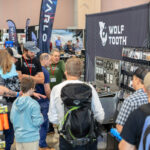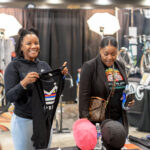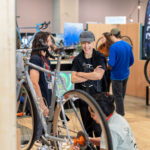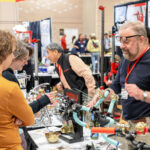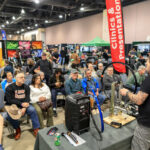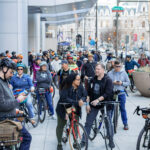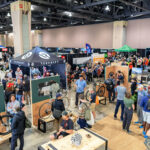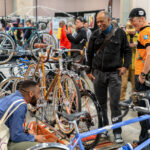
Many frame builders struggle to have a career in bicycle fabrication, but not Chris Chance. In fact in 2015 he began a second career doing just that, with a new incarnation of the feted Fat Chance brand. 2018 is his second year at Philly Bike Expo. “I felt I had to come back after last year. The feel of this show is really nice, it’s a relaxed atmosphere,” he said about the expo.
He brought three bikes with him, the Yo Eddy mountain bike, Slim Chance road bike and Chris Cross gravel bike. He would’ve added a Wicked Fat Chance gravity bike to the mix, but the finish of the show model didn’t meet his high standards so it was left back at his Sausalito, California, base.
Chance hails from the northeastern USA, with old ties in the frame building industry to the likes of Richard Sachs and Peter Weigle. Back in the 1980s and 90s, his bikes were known for being little-known. That’s to say if a good bike feels like an extension of the rider, you probably won’t be so much aware of it, rather it will do what you want without any fuss.
The remembered quality of his bikes, coupled with the catchy titles, playing on his last name, have given Chance a smooth entry back into the cycling market.
Many owners of old Yo Eddies now wanted a new one. Chance says his current models retain much of the original company philosophy of making sound bikes that are fun to ride, but they benefit from improved brakes, gears, suspension, tires and wheel sizes.
The Wicked Fat Chance enduro mountain bike, was the biggest departure from what he has done before, sporting a 65 degree head angle and 140 mm travel fork to help the rubber side down at high speeds on gnarly descents.
“I’ve never done anything with a 65 degree head angle before, that’s new territory for me,” said Chance. “You sacrifice a little on the climb and low-speed handling, but it’s a lot more stable and controllable at higher speeds. The wider handlebars contribute to that too.”

The Yo Eddy now has 3” tires, can be run as a 1×11 or a single speed, with a choice of either 27.5+ wheels or 29er. A new CNC machined ‘demi-yoke’ was needed to accommodate the wider tires, along with proprietary-design dropouts and brake mount.
Chance sells a lot of frames with standard geometry, but he has no problem going custom when needed, for example in the case of unusual torso and limb dimensions, when non-standard tube dimensions are required to properly fit and balance the rider on the bike.
Since going outside tested standards produces what are effectively prototype bikes, custom geometry is a subject he approaches with great care. “We are set up to do custom sizing,” said Chance, “but we prefer to get some very specific numbers, perhaps from somebody who has a bike dialled in already or someone who is getting a proper professional fitting done.”
“We have a couple of different avenues we can take. One is to send a customer instructions to get body measurements, or preferably have them go to a fit shop to get body dimensions.
“The other way, which I prefer, is if they’ve been fit on a bike already or if they’ve been riding long enough to be dialled in on a bike or bikes that work for them. I send them instructions on measuring up the bike dimensions they have. That’s more accurate.
“We get some customers with a bit less cycling experience who are buying the bike because they know the brand, but usually our customers are people who have had bikes and know what has worked for them. You can trust those numbers.”
Looking around at the frame builder industry since his return, Chance commented “It feels like there are a lot more people doing it now. It’s fun to see lots of creativity in frame design and components.”
